
-----
How to get heavy gold plating (5 microns+)
Q.
**1) Could the expert kindly advise:**
When preparing a decorative gold plating solution with the following formula:
- HAuCl4
- CuSO4
- NTA
- K3C6H5O7
- KH2PO4
Should the pH be maintained at 3.5 or 3.8? (Note: The pH must not be higher than this range because if the pH exceeds 4.0, the gold plating solution using HAuCl4 as the gold salt --without free cyanide-- will precipitate and hydrolyze.)
**2) When preparing a *thick* gold plating solution with the formula:**
- HAuCl4: 3.75 g / 1 liter
- Citric acid: 30 g / 1 liter
- H2SO4 (10%): 20 ml / 1 liter
- Conductive salt NH4Cl: 5 g / 1 liter
- Brightener additive (Saccharin): 2 g / 1 liter
- Distilled water: Top up to make 1 liter
Does the preparation procedure for the thick gold plating solution differ from that of the decorative gold plating solution?
For example:
a) I plan to dissolve 1g of HAuCl4 in 200 ml of distilled water, then adjust the pH to around 2 or 1.5 (i.e., lower than 2) -- This is Solution 1.
b) Then, dissolve citric acid (C6H8O7) in 500 ml of distilled water -- This is Solution 2.
c) Next, gently pour Solution 1 (gold salt solution) into Solution 2 (citric acid solution) and mix well.
d) Then add H2SO4 and stir well to stabilize the thick gold plating solution.
e) Next, add the conductive salt NH4Cl.
f) Add the brightener additive Saccharin.
h) Finally, adjust the pH and top up with distilled water to make 1 liter. (Or top up with distilled water first, then adjust the optimal pH -- 4, 5, or 6 is acceptable.)
**Question:** Among the two pH adjustment methods above, which one is more appropriate?
**3) Could the expert please clarify:**
- For decorative gold plating, the pH is typically maintained between 3.5 and 3.8. (If pH exceeds 4.0, HAuCl4 in the solution will hydrolyze.)
- For *thick* gold plating (as per the above formula), the pH is allowed to be around 4.0, 5.0, or even 6.0.
**Question:** What is the main difference between these two plating processes and formulas (thick gold plating vs. decorative gold plating)? Thank you very much for your guidance.
**4) Could the expert kindly provide the full process parameters for thick gold plating using the above formula:**
- Ideal temperature for thick gold plating?
- Voltage?
- Amperage?
- Anode connection: Should the (+) anode be connected to stainless steel, titanium mesh, or 9999 pure gold? Which option is the most effective?
- Should the solution be stirred (magnetic stirring) or not?
And in the unfortunate case that the thick gold plating solution (prepared without free cyanide, as in the given formula) results in a dark or black finish rather than a bright gold appearance -- what is the likely cause?
How should the process or formulation be adjusted to achieve a bright, shiny, yellow-gold finish on the plated object?
Thank you expert
- Ho Chi Minh, Vietnam
April 21, 2025
A. Try old ferrocyanide based gold plating solution : 200 gms potassium ferrocyanide, 50 gms gold chloride,40 gms potassium carbonate,1 lit water.Stainless steel anode, dissolve ferrocyanide in boiling water, when dissolved add carbonate and as last add gold chloride, boil 30- 180 minutes, filter when cold and use.Hope it helps and good luck!
Goran Budija- Cerovski vrh Croatia
April 25, 2025
Apologies, but after program encoding, e-mail protocols and HTML conversions, special characters such as subscripts, superscripts, and accented letters can become gibberish. This posting contains 82 characters with encoding errors :-(
If you cut & paste from files into your posting, please try to do so from plaintext files.
Q. Dear Sir,
Could you kindly guide, analyze, and evaluate whether there is any mistake in the following process for preparing the HAuCl4 gold salt solution?
1) In the process of preparing the HAuCl4 gold salt solution used for making the THICK GOLD PLATING solution (without using free cyanide), I proceed as follows:
a) Take 1 chỉ of 9999 gold (3.75 g).
b) Use aqua regia solution (just enough to dissolve 1 chỉ of 9999 gold).
c) Heat the aqua regia solution using a water bath until all the gold is dissolved! Then continue heating for another 45 minutes to evaporate the nitric acid (known as "driving off HNO₃").
d) Add 200 ml of distilled water, stirring well.
e) Let it cool for about 20 minutes. Then add urea (CO(NH₂)₂) to completely eliminate any remaining nitric acid. Stir well and let it stand for about 20 minutes.
f) Add 0.8 to 1 g of Na₂SO₃ to the gold solution, stir well, and let it stand for 55 to 60 minutes (the goal is to fully precipitate the gold).
h) After 60 minutes, the gold precipitate will settle at the bottom of the beaker. Carefully decant the clear solution above, leaving the precipitate at the bottom.
k) Use filter paper to collect the gold powder, then wash the gold powder with distilled water three times and once with hot water.
l) Dry the 9999 gold powder (3.75 g), then transfer the dried gold powder into a clean heat-resistant beaker. Add 100–120 ml of concentrated hydrochloric acid (around 36%), then add 16–18 ml of hydrogen peroxide (30%) and heat in a water bath. After all the gold powder has dissolved, continue heating for 60 minutes to fully evaporate the hydrogen peroxide (known as "driving off H₂O₂").
m) Let the solution cool for about 30 minutes, add 200 ml of distilled water, stir well, and filter again using filter paper.
n) Adjust the pH to 1.5 or lower (pH ≤ 2). At this point, a clean HAuCl₄ gold salt solution is obtained, ready to combine with the following formula:
HAuCl₄: 3.75 g / 1 liter
Citric acid (pH buffer): 30 g / 1 liter
H₂SO₄ (10% solution): 20 g / 1 liter (Note: It was originally stated: H₂SO₄ (10%–15%) : 20–50 ml. Could you please clarify the correct interpretation in this case? Thank you very much!)
NH₄Cl (conductivity agent): 5 g / 1 liter
Brighteners:
PEG: 2 g / 1 liter
Thiourea: 2 g / 1 liter
Saccharin: 2 g / 1 liter
Add distilled water to complete 1 liter.
THICK GOLD PLATING PROCESS PARAMETERS:
a) Temperature: 50–60 °C
b) Voltage: 3V to 5V
c) Current (Amps): 0.1A to 0.5A
d) Optimal pH: 4 to 6
SUMMARY:
Could you kindly tell me if there is any mistake in the above process of preparing the HAuCl4 thick gold plating solution?
Could you kindly tell me if there is any mistake in the above process of preparing the HAuCl₄ thick gold plating solution?
During the gold powder dissolution stage, when heating to drive off H₂O₂: does it make any difference whether I add 200 ml of distilled water before heating to drive off H₂O₂, compared to heating first to drive off H₂O₂ for 60 minutes and then adding 200 ml of distilled water?
How can we be sure that H₂O₂ has been completely evaporated? Could you kindly suggest a simple method for testing it? Or what is the guaranteed heating time needed to fully evaporate H₂O₂ (30%) in this situation? (Using 18 ml of H₂O₂ (30%) + 120 ml of HCl (36–38%) + 3.75 g gold powder (approximately 1 chỉ of 9999 gold)).
Is 120 ml of HCl (36–38%) + 18 ml of H₂O₂ too much (excessive) for dissolving 3.75 g of gold in this case? Is 120 ml of HCl too much? Could I reduce it to only 100 ml of HCl?
If excess HCl remains in the gold salt solution, will it affect the gold plating process?
Why, even though I strictly follow the process described above, does the thick gold plating still turn black? Could you kindly help me understand this? Thank you so much, dear expert!
- Ho Chi Minh, Vietnam
⇩ Related postings, oldest first ⇩
Q. Hello Sir,
I have been told that with flash gold plating solution there is a way to get 30-50 microns of gold onto jewelry. A person told me he have looked in a 'history of plating' book, he found that if you put about 5 times the normal amount of gold into your bath, lower the voltage and increase plating time, you can plate that thickness in an hour or so and have it come out bright. This will give a very thick and durable coating of gold. Is it possible or not -- please advise me?
I want to plate 30 to 50 microns of gold on a watch. Note:I'm not talking about 30 to 50 microinches.
Thank you,

Dipen Pattni
jeweler/goldsmith - Dar-Es-Salaam, Tanzania
2002
|
|
A. Hello, Mr. Pattni. The word "flash" usually means very thin.
30-50 microns is very very thick; I don't think even the famous century-old pocket watches had more than 20 microns. Today's super-premium watches reportedly have about 7 microns.  Ted Mooney, P.E. Striving to live Aloha finishing.com - Pine Beach, New Jersey Ted can be retained for immediate answers or long term project help A. I have seen gold plated over 1/2 inch thick but we sure did not call it "flash". The term flash is not used in the USA for heavy deposits - flash usually means about 0.000 010 inches thick or 1/4 micron. 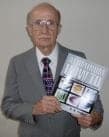 Robert H Probert Robert H Probert Technical Services Garner, North Carolina 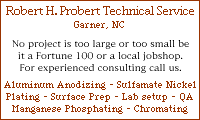 |
Q. Dear Ted,
I don't know the type of bath, but I'm buying solution from my supplier and I'm adding 68% GPC in the instagold flash bath 2 grams per gallon.
My supplier is telling me you can plate but you have to add brightener and 1 oz of GPC per gallon and you will need lot of agitation then I can plate very thick.
I want to plate 50 micron on watch, base metal is brass and SS. Please advise me is it possible or not, or I need different type of bath?
Thanks,

Dipen Pattni
jeweler/goldsmith - Dar-Es-Salaam, Tanzania
by Reid & Goldie
-- hard to find & expensive; if you see a copy cheap, act fast!
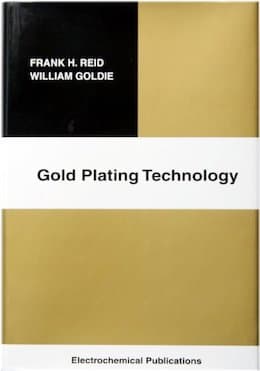
on eBay or Amazon
or AbeBooks
(affil link)
A. I'm not a hands-on gold plater, Dipen -- just a guy who reads and listens and watches. 'GPC' (gold potassium cyanide) means it a cyanide bath, which is usually not considered the best basis for a high-speed gold plating bath, but I think your supplier is advising you correctly and that you can plate a heavy thickness by increasing the gold concentration, using agitation, and employing a proper brightener.

Ted Mooney, P.E.
Striving to live Aloha
finishing.com - Pine Beach, New Jersey
Ted can be retained for immediate
answers or long term project help
Q. Dear Ted :)
I know you read and listen and watch. I'm sure that my bath is not a cyanide strike bath. Anyway I'll spend 1 oz of GPC and brightener to let see what happens ;(
My supplier is Gold Touch [a finishing.com supporting advertiser] they have advised me a lot but they have never done heavy thicknesses like I want. So I thought let me post the question on finishing.com, masters like Mr.Ted or others can help me. My english is not good, please try to understand.
Thanks,

Dipen Pattni
jeweler/goldsmith - Dar-Es-Salaam, Tanzania
(affil links)
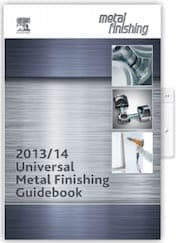
free pdf is currently available from academia.edu
A. It's not clear to me if you are running alkaline cyanide gold or acid gold cyanide. What is the pH?
According to Al Weisberg's great article in the Metal Finishing Guidebook, you should have 4-8 g/L of gold for heavy deposits. This is much much higher than you previously had. He notes the use of either cobalt or nickel for alloying, agitation required, a current density of 10-20 A/ft2, and temperatures between 80 and 100 °F.

Ted Mooney, P.E.
Striving to live Aloha
finishing.com - Pine Beach, New Jersey
Ted can be retained for immediate
answers or long term project help
Q. Dear Mr. Ted,
Solution powder itself does not contain the cyanide, type of bath is acid gold bath that is both electrolytic and immersion, pH is 4.4 to 4.8.
Thanks,

Dipen Pattni
jeweler/goldsmith - Dar-Es-Salaam, Tanzania
A. Hi. I'd bet that powder is GPC, potassium gold cyanide. If so, this bath is usually called an acid gold cyanide bath.
Luck & Regards,
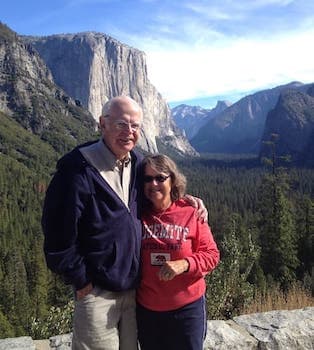
Ted Mooney, P.E. RET
Striving to live Aloha
finishing.com - Pine Beach, New Jersey
Ted can be retained for immediate
answers or long term project help
Multiple threads merged: please forgive chronology errors and repetition 🙂
Q. I don't seem to be able to get a straight answer from my supplier. I'm currently using a cyanide based gold plating solution. This is one of the common solutions used in the Jewellery business. I'm gold plating base metal rings and I cannot get a thick coat of gold deposit on the items. The directions for the plating bath are the following:
Heat at 130-140 °F and plate with 5-6 Volts for about 15-30 seconds, using a Stainless Steel anode.
By doing that I only get a flash and sometimes when I lightly buff the piece with a cloth the plating goes away. I tried to lower the voltage to 2.5-3 Voltage and increase the plating time to about 1.5-2 minutes. The same happens. And when I plate for about 5 minutes the plating becomes too dull and dark.
Another company sells a K24 gold plating solution that according to what they say it will plate 2 microns in 2 minutes. And if I need to pate thicker just leave it longer and then wipe the piece to remove the dull finish. I don't know if I can trust this.
Any ideas? I need to have a bright thick gold plating that will last for years. A plating I can engrave on.
Thank you in advance for your time.
Jewellery and watch case plater and refinisher - Montreal, Quebec, Canada
September 12, 2008
A. The company that told you they have a gold bath that will plate 2 microns (over 80 microinches) in 2 minutes was in error, unless the gold concentration of the bath is way up there, and who can afford that nowadays. Secondly, the bath you are using now is made for what you say, "a flash coating". The bath could also be low in gold. The deposit should not just rub off, even at 5-7 microinches thickness. Why do you want to plate 2 microns of gold on jewelry? If you want a thicker deposit you will have to increase the gold concentration and other constituents in the bath. You could plate 25 microinches max if you want a quality product. You will have to sell the rings for a lot more though because you are putting on almost 5X the amount of gold than the average jewelry plater. Good Luck!
Mark Bakerprocess engineer - Malone, New York
Readers who are interested in the formulation of baths, and the operational considerations, for very heavy gold plating may also be interested in these related threads:
• Topic #348/21 "Gold flash vs. plate"
• Topic #30/00 "Problems in Gold plating"
Q, A, or Comment on THIS thread -or- Start a NEW Thread